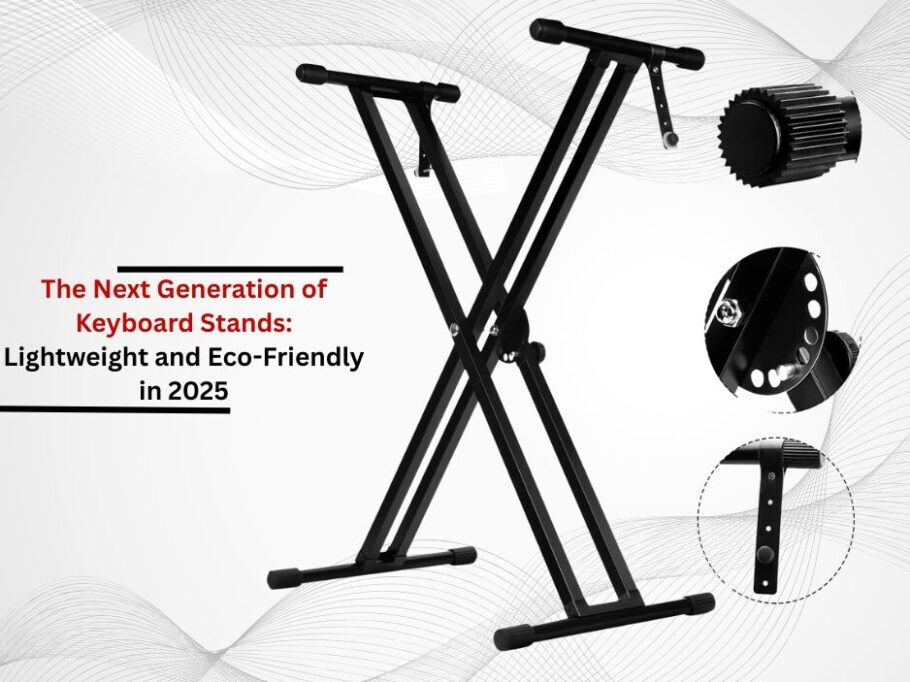With people’s environmental awareness continuing to impact industries, the musical gear world is slowly transforming. The once neglected keyboard stand has now become a spearhead for eco-friendly innovation. Newer technologies in materials science and manufacturing are making it possible to construct more fuel-efficient and environmentally friendly stands by 2025. It reflects a shift in the demand for gear that not only performs well but is also ecologically sound.
To know more, Read: How Keyboard Stands Have Adapted to Musicians’ Needs Over the Decades Leading to 2025
The advancement of materials and designs
From steel to sustainable composites:
The industry is now moving from traditional steel and aluminum stands to more eco-friendly and recyclable solid biodegradable materials. Stands made of bamboo composites, ocean reclaimed plastics, and mycelium-based polymers are quickly taking root as the standard due to the strength without added carbon cost. These new materials are designed to endure harsh use while also being lightweight. Easier to transport for touring artists, the stands also lower emissions for shipping.
Modularity and minimalist engineering:
Modular designs are a feature of next-gen stands and allow for components to be disassembled, repaired, or recycled. Waste reduction is achieved through interlocking joints and tool-free assembly systems. Portable collapsible frameworks and slimmer profiles also allow for better efficiency, making both home studios and compact venues use them.
Environmentally Friendly Developments in Manufacturing
Circular Production Models:
Manufacturers are adopting closed-loop systems in which old stands are gathered, dismantled, and transformed into new ones. Pasco’s changes include replacing water-based adhesives with less toxic finishes and completely withdrawing the use of solvents. And, energy-saving 3D printing processes are now being applied for the custom production of brackets and fittings, which eliminates overproduction.
Eco-Friendly Carbon Neutral Certificate:
Some prominent companies are now offsetting emissions through investment in reforestation and renewable energy. Stands are shipped in so-called ‘green’ containers that are made of biodegradable materials and contain seeds aimed at fostering post-unboxing planting. Such initiatives are deeply imprinted into the minds of eco-friendly musicians and build loyalty for corporations that try to accomplish joint environmental aims.
Lightweight Engineering Without Compromise
Advanced alloys and hybrid materials:
Aerospace-grade alloys, such as polymers with graphene, provide new possibilities in composing materials because of their unparalleled strength relative to their weight. Stands that weigh less than 5 pounds can now support more than 150 pounds of instruments, which is very beneficial for mobile performers. And the non-slip, textured grip that is applied does not add any significant weight, ensuring better performance stability during dynamic acts.
Energy Harvesting Features:
Kinetic energy from keystrokes is being captured through piezoelectric components that power built-in USB ports or LED indicators. Outdoor models are supplemented with solar-reactive coatings that provide additional energy, making the device self-sufficient and less dependent on external power sources.
User-Centric Functions
Ergonomic Flexibility:
Height and tilt movements are now automated and controlled by biometric scanners, which examine a user’s posture and provide suggestions through mobile applications. Attending to long sitting practice sessions, the memory-preset hydraulics permit effortless transitions between seated and standing positions.
Aesthetic Personalization:
Green stands also come in colors, shapes, and textures other than utilitarian. Recyclable fabrics and biodegradable resins as substitutes for panels allow musicians to personalize texture and color. Art is functional, and so are laser-etched patterns and moss-infused finishes that blur the distinction between gear and art.
The Path forward: Beyond 2025
Artificial Intelligence-Powered Lifecycle Assessment:
AI-powered maintenance prediction, recommended recycling, and task suggestions are attributed to the AI’s ability to anticipate upkeep requirements and furnish recycling recommendations. Sensors embedded in the stands track their structural condition and notify users of potential wear via apps connected to the cloud. This helps guarantee that stands endure throughout their lifecycle and reduces waste. Stands excel in upholding sustainability.
Design Led By Community Initiatives:
Musicians are permitted to post concepts related to improvements of the stand on collaborative AI and open source platforms. This participatory technique supports products to develop in line with environmental and artistic needs and enhances shared ownership within society.
Conclusion
2025’s keyboard stands demonstrate the possible coexistence of advancement and ecology. Through lightweight components, circular economies, and purposeful design, these stands are ergonomic not just for the musicians but for nature too. Brands like 5 Core, RockJam, K&M, Chromecast, and Roland are leading the charge because, as these brands show, sustainability and performance can indeed work together. As the industry advances toward a greener future, the keyboard stand will silently witness both musical and environmental progress.





